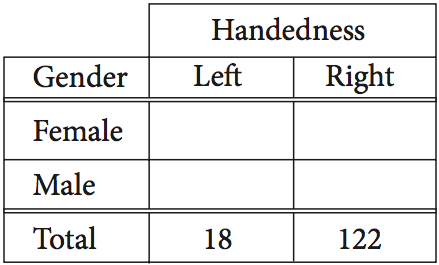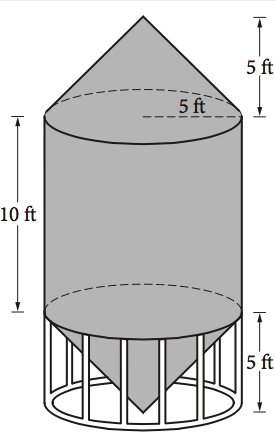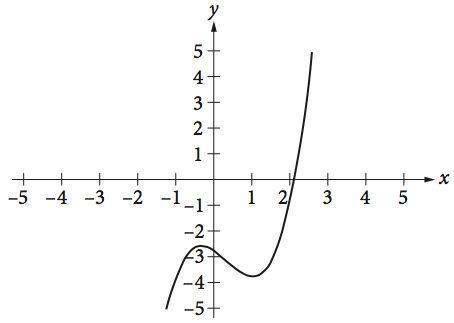The 15 Hardest SAT Math Questions
No Calculator SAT Math Questions
Question 1
The equation above shows how temperature F C
- A temperature increase of 1 degree Fahrenheit is equivalent to a temperature increase of
5 9 - A temperature increase of 1 degree Celsius is equivalent to a temperature increase of 1.8 degrees Fahrenheit.
- A temperature increase of
5 9
A) I only
B) II only
C) III only
D) I and II only
B) II only
C) III only
D) I and II only
ANSWER EXPLANATION: Think of the equation as an equation for a line
where in this case
or
You can see the slope of the graph is
Therefore, statement I is true. This is the equivalent to saying that an increase of 1 degree Celsius is equal to an increase of
Since
The only answer that has both statement I and statement II as true is D, but if you have time and want to be absolutely thorough, you can also check to see if statement III (an increase of
An increase of
The final answer is D.
Question 2
The equation
What is the value of a
A) -16
B) -3
C) 3
D) 16
B) -3
C) 3
D) 16
ANSWER EXPLANATION: There are two ways to solve this question. The faster way is to multiply each side of the given equation by a x − 2 a x − 2
You should then multiply ( − 8 x − 3 ) ( a x − 2 )
Then, reduce on the right side of the equation
Since the coefficients of the x 2 − 8 a = 24 a = − 3
The other option which is longer and more tedious is to attempt to plug in all of the answer choices for a and see which answer choice makes both sides of the equation equal. Again, this is the longer option, and I do not recommend it for the actual SAT as it will waste too much time.
The final answer is B.
Question 3
If 3 x − y = 12
A) 2 12
B)4 4
C)8 2
D) The value cannot be determined from the information given.
B)
C)
D) The value cannot be determined from the information given.
ANSWER EXPLANATION: One approach is to express
so that the numerator and denominator are expressed with the same base. Since 2 and 8 are both powers of 2, substituting 2 3
which can be rewritten
Since the numerator and denominator of have a common base, this expression can be rewritten as 2 ( 3 x − y ) 3 x − y = 12 3 x − y
The final answer is A.
Question 4
Points A and B lie on a circle with radius 1, and arc
ANSWER EXPLANATION: To figure out the answer to this question, you'll first need to know the formula for finding the circumference of a circle.
The circumference, C C = 2 π r r C = 2 ( π ) ( 1 ) C = 2 π
To find what fraction of the circumference the length of
The fraction
The final answer is
Question 5
If the expression above is rewritten in the form a + b i a b a i = √ − 1
ANSWER EXPLANATION: To rewrite
Since i 2 = − 1
which simplifies further to 2 + i
The final answer is A.
Question 6
In triangle A B C ∠ B B C = 16 A C D E F A B C D E F A B C D E F
ANSWER EXPLANATION: Triangle ABC is a right triangle with its right angle at B. Therefore, A C A B B C
Since triangle DEF is similar to triangle ABC, with vertex F corresponding to vertex C, the measure of angle ∠ F angle ∠ C s i n F = s i n C
Therefore, s i n F =
The final answer is
Calculator-Allowed SAT Math Questions
Question 7

The incomplete table above summarizes the number of left-handed students and right-handed students by gender for the eighth grade students at Keisel Middle School. There are 5 times as many right-handed female students as there are left-handed female students, and there are 9 times as many right-handed male students as there are left-handed male students. if there is a total of 18 left-handed students and 122 right-handed students in the school, which of the following is closest to the probability that a right-handed student selected at random is female? (Note: Assume that none of the eighth-grade students are both right-handed and left-handed.)
A) 0.410
B) 0.357
C) 0.333
D) 0.250
B) 0.357
C) 0.333
D) 0.250
ANSWER EXPLANATION: In order to solve this problem, you should create two equations using two variables (x y x y 5 x 9 y
When you solve this system of equations, you get x = 10 y = 8
Questions 8 & 9
Use the following information for both question 7 and question 8.
If shoppers enter a store at an average rate of r T N N = r T
The owner of the Good Deals Store estimates that during business hours, an average of 3 shoppers per minute enter the store and that each of them stays an average of 15 minutes. The store owner uses Little's law to estimate that there are 45 shoppers in the store at any time.
Question 8
Little's law can be applied to any part of the store, such as a particular department or the checkout lines. The store owner determines that, during business hours, approximately 84 shoppers per hour make a purchase and each of these shoppers spend an average of 5 minutes in the checkout line. At any time during business hours, about how many shoppers, on average, are waiting in the checkout line to make a purchase at the Good Deals Store?
ANSWER EXPLANATION: Since the question states that Little's law can be applied to any single part of the store (for example, just the checkout line), then the average number of shoppers, N N = r T r T
Since 84 shoppers per hour make a purchase, 84 shoppers per hour enter the checkout line. However, this needs to be converted to the number of shoppers per minute (in order to be used with T = 5
Therefore, the average number of shoppers, N
The final answer is 7.
Question 9
The owner of the Good Deals Store opens a new store across town. For the new store, the owner estimates that, during business hours, an average of 90 shoppers per hour enter the store and each of them stays an average of 12 minutes. The average number of shoppers in the new store at any time is what percent less than the average number of shoppers in the original store at any time? (Note: Ignore the percent symbol when entering your answer. For example, if the answer is 42.1%, enter 42.1)
ANSWER EXPLANATION: According to the original information given, the estimated average number of shoppers in the original store at any time (N) is 45. In the question, it states that, in the new store, the manager estimates that an average of 90 shoppers per hour (60 minutes) enter the store, which is equivalent to 1.5 shoppers per minute (r). The manager also estimates that each shopper stays in the store for an average of 12 minutes (T). Thus, by Little's law, there are, on average, N = r T = ( 1.5 ) ( 12 ) = 18
percent less than the average number of shoppers in the original store at any time.
The final answer is 60.
Question 10
In the x y ( p , r ) y = x + b b ( 2 p , 5 r ) y = 2 x + b p ≠ 0
A)
B)
C)
D)
ANSWER EXPLANATION: Since the point ( p , r ) y = x + b p x r y y = x + b r = p + b b r − p
Similarly, since the point ( 2 p , 5 r ) y = 2 x + b 2 p x 5 r y y = 2 x + b
Next, we can set the two equations equal to b
Finally, to find
The correct answer is B,
If you picked choices A and D, you may have incorrectly formed your answer out of the coefficients in the point ( 2 p , 5 r ) r p
Note that while this is in the calculator section of the SAT, you absolutely do not need your calculator to solve it!
Question 11
 A grain silo is built from two right circular cones and a right circular cylinder with internal measurements represented by the figure above. Of the following, which is closest to the volume of the grain silo, in cubic feet?
A grain silo is built from two right circular cones and a right circular cylinder with internal measurements represented by the figure above. Of the following, which is closest to the volume of the grain silo, in cubic feet?
A) 261.8
B) 785.4
C) 916.3
D) 1047.2
B) 785.4
C) 916.3
D) 1047.2
ANSWER EXPLANATION: The volume of the grain silo can be found by adding the volumes of all the solids of which it is composed (a cylinder and two cones). The silo is made up of a cylinder (with height 10 feet and base radius 5 feet) and two cones (each with height 5 ft and base radius 5 ft). The formulas given at the beginning of the SAT Math section:
Volume of a Cone
Volume of a Cylinder
can be used to determine the total volume of the silo. Since the two cones have identical dimensions, the total volume, in cubic feet, of the silo is given by
which is approximately equal to 1,047.2 cubic feet.
The final answer is D.
Question 12
If x m 9 , y 2 m 15 , and z 3 m 18 , what is the average of x y z m
A) m + 6
B)m + 7
C)2 m + 14
D)3 m + 21
B)
C)
D)
ANSWER EXPLANATION: Since the average (arithmetic mean) of two numbers is equal to the sum of the two numbers divided by 2, the equations x =
This fraction can be simplified to m + 7
The final answer is B.
Question 13

The function f ( x ) = x 3 − x 2 − x −
ANSWER EXPLANATION: The equation f ( x ) = k
and
A real solution of a system of two equations corresponds to a point of intersection of the graphs of the two equations in the x y
The graph of y = k ( 0 , k ) y = − 3 f ( x ) = − 3 k − 3
The final answer is D.
Question 14
The dynamic pressure q v n v v
ANSWER EXPLANATION: To solve this problem, you need to set up to equations with variables. Let q 1 v 1 q 2 v 2
Given the equation q =
Therefore, the ratio of the dynamic pressure of the faster fluid is
The final answer is 2.25 or 9/4.
Question 15
For a polynomial p ( x ) p ( 3 ) − 2 p ( x )
A) x − 5 p ( x )
B)x − 2 p ( x )
C)x + 2 p ( x )
D) The remainder whenp ( x ) x − 3 − 2
B)
C)
D) The remainder when
ANSWER EXPLANATION: If the polynomial p ( x ) x + k
where q ( x ) r x + k x 1
Therefore, p ( x ) p ( x ) = ( x + k ) q ( x ) + r r
The question states that p ( 3 ) = − 2
Now we can plug in all the possible answers. If the answer is A, B, or C, r 0 , while if the answer is D, r − 2
A. − 2 = p ( 3 ) = ( 3 + ( − 5 ) ) q ( 3 ) + 0
− 2 = ( 3 − 5 ) q ( 3 )
− 2 = ( − 2 ) q ( 3 )
This could be true, but only if q ( 3 ) = 1
B. − 2 = p ( 3 ) = ( 3 + ( − 2 ) ) q ( 3 ) + 0
− 2 = ( 3 − 2 ) q ( 3 )
− 2 = ( − 1 ) q ( 3 )
This could be true, but only if q ( 3 ) = 2
C. − 2 = p ( 3 ) = ( 3 + 2 ) q ( 3 ) + 0
− 2 = ( 5 ) q ( 3 )
This could be true, but only if q ( 3 ) =
D. − 2 = p ( 3 ) = ( 3 + ( − 3 ) ) q ( 3 ) + ( − 2 )
− 2 = ( 3 − 3 ) q ( 3 ) + ( − 2 )
− 2 = ( 0 ) q ( 3 ) + ( − 2 )
This will always be true no matter what q ( 3 )
Of the answer choices, the only one that must be true about p ( x ) p ( x ) x − 3
The final answer is D.





No comments:
Post a Comment